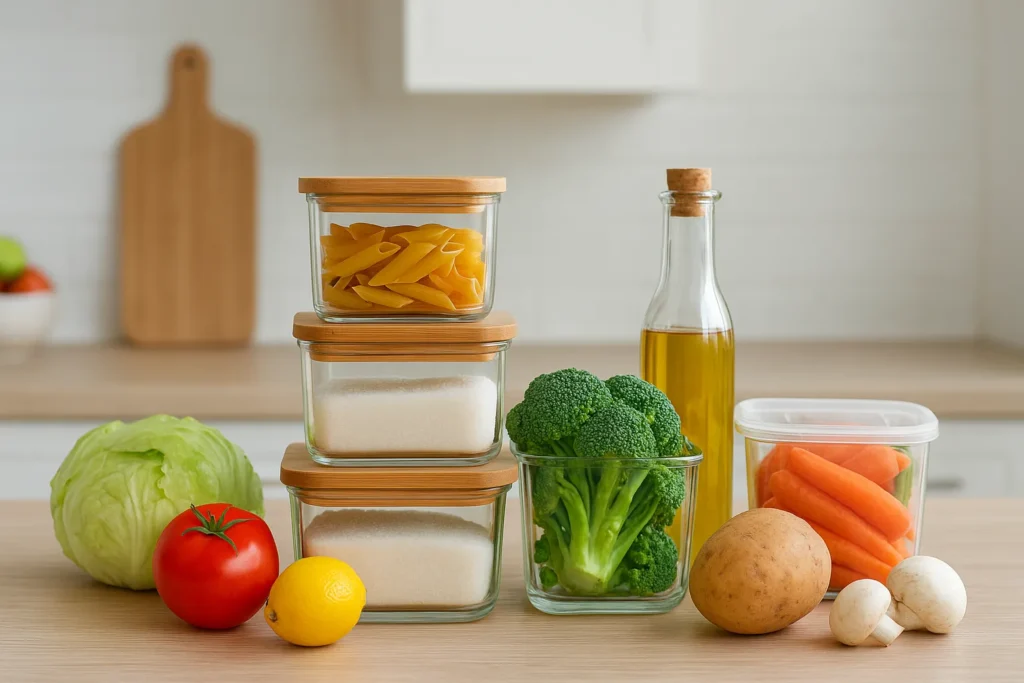
Ever opened your fridge and found that your once-fresh veggies have turned into sad, wilting masses of mush? Or maybe you’ve discovered a half-eaten loaf of bread that somehow transformed into an archaeological find. Well, you’re not alone. Keeping your food fresh and understanding its shelf life isn’t just for professional chefs or food critics. It’s something we all can master with a little knowledge, a few simple tips, and some organizational skills. Let’s dive into the science and art of food storage and how you can extend the life of your favorite ingredients!
1. The Fridge: Your Food’s Best Friend (When Used Right)
Most of us think we’re doing a solid job by shoving everything into the fridge and calling it a day. But did you know that certain foods actually do better outside the cold zone? Tomatoes, for instance, lose their flavor and texture when chilled. And don’t even get me started on potatoes—those starchy spuds will turn into a sweet, sad mess if left to chill in the fridge for too long.
So, let’s talk fridge organization. It’s not just about cramming your leftovers in and closing the door with a hopeful prayer. The upper shelves are great for leftovers, drinks, and ready-to-eat items. The lower shelves, where it’s coldest, are perfect for meats and dairy products. As for the veggie drawers, they’re not just for show. Those crisper bins are actually meant to keep your fruits and veggies at their best, so don’t neglect them!
2. Freezing for Success: More Than Just Ice Cream Storage
Freezing is often thought of as the last resort when food is about to expire. But with the right approach, freezing can extend your food’s shelf life by months (and sometimes years). The trick is to freeze your food at the peak of its freshness. And don’t just toss everything into one giant freezer bag—air is the enemy here. Make sure you use airtight containers or freezer bags designed for the job. For fruits and veggies, it’s a good idea to blanch them first (a quick dip in boiling water and then ice water) to preserve flavor and texture.
Pro tip: Label everything with the date you froze it. Trust me, future-you will thank present-you when you find that mystery bag of “something” three months later.
3. Dry Storage: Keeping Pantry Staples in Tip-Top Shape
Your pantry is basically a mini food warehouse, and it’s crucial to store your dry ingredients properly. Those grains, pasta, and cereals need a dry, cool environment away from light to prevent spoilage. Keep those pantry items in airtight containers to avoid pests (no one wants ants in their rice) and to keep them from going stale.
For spices, keep them in a cool, dark place. Avoid storing them near heat sources like stoves or direct sunlight because that can cause them to lose their flavor faster. And let’s be real—there’s nothing quite as sad as a bottle of garlic powder that’s lost its “oomph.”
4. The Power of the Right Containers
Not all food storage containers are created equal. While plastic Tupperware might be convenient, it’s not always the best at keeping your food fresh. Glass containers are great because they don’t absorb odors or stain over time. Plus, they often create a better seal, helping to keep moisture out and freshness in. Stainless steel containers are also excellent for keeping food fresh without the risk of harmful chemicals leaching into your food. If you’re looking to reduce plastic, consider investing in reusable silicone bags for snacks or produce.
One golden rule: never store hot food in containers right after cooking. Give it a little time to cool down. Storing hot food in an airtight container can create moisture, which encourages bacteria growth.
5. The Shelf Life of Your Favorite Foods
Okay, so how long do your beloved foods really last? Here’s a general breakdown for some common items (but remember, these are just guidelines — always check for signs of spoilage!):
- Fresh Meat: 1-2 days in the fridge, 6-12 months in the freezer.
- Dairy: Milk can last 5-7 days after its “sell by” date, while cheese can last up to a month if stored correctly in the fridge.
- Eggs: About 3-5 weeks in the fridge. Pro tip: to check if an egg is still good, place it in a bowl of water. If it floats, it’s time to say goodbye.
- Fruits and Vegetables: Most fruits last about a week in the fridge, but some, like apples, can last up to a month if stored properly. As for leafy greens, they’re best used within 3-5 days.
6. Can You Really Extend the Life of Your Produce?
Yes, you can! First, let’s talk about ethylene gas. Some fruits, like apples, bananas, and avocados, produce this gas, which can speed up the ripening of nearby produce. Keep these items separate from sensitive fruits and vegetables like carrots and lettuce to keep them fresh longer.
For leafy greens, wash and dry them thoroughly before storing them in a breathable container (a salad spinner is your friend here). You can also wrap them in a paper towel to absorb excess moisture, which helps prevent wilting.
7. The Art of Repacking and Rotating
When food starts to lose its freshness, don’t just toss it in the back of the fridge or pantry. Repacking can save a lot of ingredients from going to waste. For instance, if you have a bunch of mixed veggies that are starting to wilt, repack them in an airtight container with a bit of water. This will help rehydrate them, giving you a few more days of use.
And don’t forget about the golden rule of pantry management: First In, First Out (FIFO). This means using older items before newer ones. It’s like a grocery store, but you’re the one reaping the benefits.
